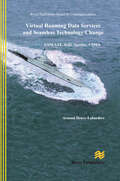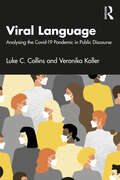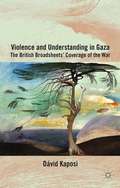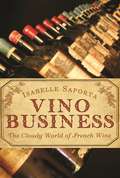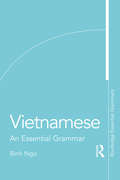- Table View
- List View
Virtual Roaming Data Services and Seamless Technology Change: GSM, LTE, WiFi, Satellite, CDMA
by Arnaud Henry-LabordèreThe subject is “Virtual Roaming for data services” and “Seamless Technology change” also called “Number Continuity”.“Virtual Roaming for voice and SMS” was covered in one of the author's previous book. “Virtual Roaming” means that it allows a subscriber to visit a network which his home network does not have an agreement with. The “Seamless Technology change” allows a user to keep all his services including reception of calls and SMS sent to his usual number when he switches his GSM to a Satellite phone or to WiFi. The implementation of Seamless Technology change uses the SS7 Roaming Hub and GTP Hubs technology explained in the first part of the book. The book also contains chapters explaining in detail the steering and anti-steering of roaming, LTE Serving Mobile Location Centers, and Advanced Policy and Charging implementations in LTE and 3G. This is to be used as an easy reference book. All the relevant references to the standards are included chapter by chapter. This is the first book on the two main subjects of Virtual Data Roaming and Seamless Technology change. Keywords:Virtual Roaming, Number Continuity, Seamless technology change, Policy Charging and Control, LTE LBS, Steering of Roaming, GTP Hub, MMS Hub,RADIUS Hub, DIAMETER Hub
Virtual Private Networking: A Construction, Operation and Utilization Guide
by Gilbert HeldThis book provides network managers, LAN administrators and small business operators with all they need to know to "interconnect" multiple locations or travelling employees that need to access a single location. The operation and utilization of virtual private networks is discussed both in theory and practicality, covering the technical aspects associated with encryption and digital certificates as well as the manner by which readers can create VPNs using readily available products from Microsoft, Cisco, Checkpoint and possibly other vendors. The author was among the first to write about the concept of virtual private networking in a series of articles published over five years ago, and in the intervening years this has become a very hot topic - with the technology being increasing deployed by companies. Virtual Private Networking, by Gilbert Held, covers the technology and the theory, but also shows readers, through numerous examples, 'how to use ' the technology.
Virtual Presenting: A Guide to Formats, Production and Authentic Delivery
by Jamie Cohen Michael SorrentinoResponding to the widespread and continued acceleration of virtual working practices in recent years, Virtual Presenting provides a clear guide to producing, presenting, and broadcasting in a remote context. Unlike traditional studio production where a presenter is surrounded by a crew and cameras, the virtual presenter is often isolated or connected to a remote crew. Virtual Presenting explains how to make an authentic connection across great spaces, linked only via the Internet. Topics covered include how to build a virtual setup; how to appear on camera; how to appear confident and comfortable; and how to optimize your presentation voice. The authors demonstrate how to tell effective stories across the entire new media landscape of webcasting, webinars, livestreams, and virtual events. Finally, success stories and case studies from teachers, students, and professionals are interwoven to show how these guidelines translate into best practices. Virtual Presenting will be a valuable resource for students of media production and remote broadcasting as well as professionals looking to become stronger communicators and visual presenters.
Virtual Presenting: A Guide to Formats, Production and Authentic Delivery
by Jamie Cohen Michael SorrentinoResponding to the widespread and continued acceleration of virtual working practices in recent years, Virtual Presenting provides a clear guide to producing, presenting, and broadcasting in a remote context. Unlike traditional studio production where a presenter is surrounded by a crew and cameras, the virtual presenter is often isolated or connected to a remote crew. Virtual Presenting explains how to make an authentic connection across great spaces, linked only via the Internet. Topics covered include how to build a virtual setup; how to appear on camera; how to appear confident and comfortable; and how to optimize your presentation voice. The authors demonstrate how to tell effective stories across the entire new media landscape of webcasting, webinars, livestreams, and virtual events. Finally, success stories and case studies from teachers, students, and professionals are interwoven to show how these guidelines translate into best practices. Virtual Presenting will be a valuable resource for students of media production and remote broadcasting as well as professionals looking to become stronger communicators and visual presenters.
Virtual Networks: Pluralistic Approach for the Next Generation of Internet
by Otto Carlos M.B. Duarte Guy PujolleThe first chapter of this title concerns virtualization techniques that allow sharing computational resources basically, slicing a real computational environment into virtual computational environments that are isolated from one another. The Xen and OpenFlow virtualization platforms are then presented in Chapter 2 and a performance analysis of both is provided. This chapter also defines the primitives that the network virtualization infrastructure must provide for allowing the piloting plane to manage virtual network elements. Following this, interfaces for system management of the two platforms are proposed in Chapter 3. To control and manage virtual network elements, five primitives that the network virtualization infrastructure must provide are defined: instantiate, delete, migrate, monitor and set. The book then moves on to survey existing control algorithms for virtual networking. It also describes the main challenges for packet forwarding using Xen as a virtualization tool and describes, in more detail, a proposal for local control of virtual networks. Within each physical node, this proposal guarantees the service level acquired by each virtual network, even in the presence of misbehaving virtual networks. Contents 1. Virtualization, Luís Henrique M.K. Costa. 2. Virtual Network Interfaces, Miguel Elias M. Campista. 3. Performance Improvement and Control of Virtual Network Elements, Igor M. Moraes. 4. State of the Art in Context-Aware Technologies, Edmundo R.M. Madeira and Guy Pujolle. 5. Providing Isolation and Quality-of-Service to Virtual Networks, Miguel Elias M. Campista. 6. Piloting System, Edmundo R.M. Madeira and Nelson Luis S. Da Fonseca. 7. Management and Control: The Situated View, Otto Carlos M.B. Duarte. 8. System Architecture Design, Otto Carlos M.B. Duarte. About the Authors Otto Carlos M.B. Duarte is Full Professor at Universidade Federal do Rio de Janeiro in Brazil, where he has worked since 1978. His research interests include mobile communications, security, multicast, and QoS guarantees. Guy Pujolle is currently Professor at University Pierre and Marie Curie (Paris VI) in France and a member of the Scientific Advisory Board of Orange/France Telecom Group. He has published widely in the area of computer systems modeling and performance, queuing theory, high-speed networks, intelligence in networking, wireless networks, and Post-IP networks, including 19 influential texts and monographs in these areas.
Virtual Networks: Pluralistic Approach for the Next Generation of Internet
by Guy Pujolle Otto Carlos M. B. DuarteThe first chapter of this title concerns virtualization techniques that allow sharing computational resources basically, slicing a real computational environment into virtual computational environments that are isolated from one another. The Xen and OpenFlow virtualization platforms are then presented in Chapter 2 and a performance analysis of both is provided. This chapter also defines the primitives that the network virtualization infrastructure must provide for allowing the piloting plane to manage virtual network elements. Following this, interfaces for system management of the two platforms are proposed in Chapter 3. To control and manage virtual network elements, five primitives that the network virtualization infrastructure must provide are defined: instantiate, delete, migrate, monitor and set. The book then moves on to survey existing control algorithms for virtual networking. It also describes the main challenges for packet forwarding using Xen as a virtualization tool and describes, in more detail, a proposal for local control of virtual networks. Within each physical node, this proposal guarantees the service level acquired by each virtual network, even in the presence of misbehaving virtual networks. Contents 1. Virtualization, Luís Henrique M.K. Costa. 2. Virtual Network Interfaces, Miguel Elias M. Campista. 3. Performance Improvement and Control of Virtual Network Elements, Igor M. Moraes. 4. State of the Art in Context-Aware Technologies, Edmundo R.M. Madeira and Guy Pujolle. 5. Providing Isolation and Quality-of-Service to Virtual Networks, Miguel Elias M. Campista. 6. Piloting System, Edmundo R.M. Madeira and Nelson Luis S. Da Fonseca. 7. Management and Control: The Situated View, Otto Carlos M.B. Duarte. 8. System Architecture Design, Otto Carlos M.B. Duarte. About the Authors Otto Carlos M.B. Duarte is Full Professor at Universidade Federal do Rio de Janeiro in Brazil, where he has worked since 1978. His research interests include mobile communications, security, multicast, and QoS guarantees. Guy Pujolle is currently Professor at University Pierre and Marie Curie (Paris VI) in France and a member of the Scientific Advisory Board of Orange/France Telecom Group. He has published widely in the area of computer systems modeling and performance, queuing theory, high-speed networks, intelligence in networking, wireless networks, and Post-IP networks, including 19 influential texts and monographs in these areas.
Virtual Memory (tactile)
by RnibThis diagram shows an example of virtual memory. The parts that are labelled are: page; offset; pages table; +; memory.
Virtual Facilitation and Meetings: Your Desktop Reference to Running a Successful Online Classroom (Wordcatcher Professional Development)
by Kevin McAlpinAre you a coach, consultant, teacher, trainer, educator, or learning and development professional? Are you looking to transfer your knowledge and expertise into the virtual world? Whether you are new to delivering education online, or an experienced and successful virtual facilitator who wants to hone their skills, this book is for you. This book will help coaches, consultants, teachers, trainers, lecturers, educators, and learning and development professionals. Deliver industry-leading sessions using effective strategies and you will engage your participants to get the results they want. The global pandemic has changed the way the world does business, perhaps forever. Many activities that were carried out face-to-face are now being done in the virtual world without a second thought. We estimate that up to half of face-to-face facilitation will be replaced by virtual delivery even after the ‘new normal’ returns to our professional lives. This new world requires significant new skills, not least for learning and development. It offers new challenges to overcome, but big opportunities for those who embrace it. You will learn how to: Transfer your face-to-face skills to a virtual environment Understand the significant differences between real-world and online learning Recognise the technical challenges Use interactive and participative tools to deliver engaging sessions Understand the concept of blended learning and how to apply it The types of events this will help you to manage include: virtual classrooms team-building events in-house training leadership and talent development meetings conferences Embed your understanding of virtual facilitation, and learn new ways to delivery existing content in a learning environment that has been changed forever.
Virtual Culture: Identity and Communication in Cybersociety
by Steven JonesVirtual Culture marks a significant intervention in the current debate about access and control in cybersociety exposing the ways in which the Internet and other computer-mediated communication technologies are being used by disadvantaged and marginal groups - such as gay men, women, fan communities and the homeless - for social and political change. The contributors to this book apply a range of theoretical perspecitves derived from communication studies, sociology and anthropology to demonstrate the theoretical and practical possibilities for cybersociety as an identity-structured space.
Virtual Culture: Identity and Communication in Cybersociety (PDF)
by Steven JonesVirtual Culture marks a significant intervention in the current debate about access and control in cybersociety exposing the ways in which the Internet and other computer-mediated communication technologies are being used by disadvantaged and marginal groups - such as gay men, women, fan communities and the homeless - for social and political change. The contributors to this book apply a range of theoretical perspecitves derived from communication studies, sociology and anthropology to demonstrate the theoretical and practical possibilities for cybersociety as an identity-structured space.
Virginia Woolf, Literary Materiality, and Feminist Aesthetics: From Pen to Print (Material Modernisms)
by Amber JenkinsThis book interrogates the relationship between the material conditions of Woolf's writing practices and her work as a printer and publisher at the Hogarth Press. In bringing to light her embodied literary processes, from drafting and composition to hand-printing and binding, this study foregrounds the interactions between Woolf's modernist experimentation and the visual and material aspects of her printed works. By drawing on the field of print culture, as well as the materialist turn in Woolf scholarship, it explores how her experience in print, book-design and publishing underlines her experimental writing, and how her literary texts are conditioned by the context of their production. This book, therefore, provides new ways of reading Woolf's modernism in the context of twentieth-century print, material, and visual cultures. By suggesting that Woolf's work at the Hogarth Press sensitized her to the significant role the visual aspects of a text play in its system of representation, it also considers the extent to which materiality informs both her work, as well as her engagement with Bloomsbury formalist aesthetics, which often exaggerate the distinction between visual and verbal modes of expression.
Viral Loop: The Power of Pass-It-On
by Adam PenenbergHere’s how it works: you read a book, you recommend it to a friend. That friend tells another friend. And another... until the book becomes this year’s word-of-mouth sensation. This is the first to analyze the power of the 'pass-it-on’ phenomenon, introducing us to the architects of the mightily efficient, money-spinning model known as the Viral Loop - the secret behind some of the most successful businesses in recent history. Outfits such as Google, eBay, Flickr and Facebook all employ the model at their core; all have seen their stock valuations skyrocket within years of forming. The genius lies in the model’s reliance on replication: what’s the point of using Facebook if none of your friends can see your profile, or using Flickr if you can’t share your photos? Where’s the joy in posting a video on YouTube if no one watches it? Thus, in creating a viral product that people want, need and desire, growth can, and will, take care of itself. Find out why the Loop will catch us all up, sooner rather than later...
Viral Language: Analysing the Covid-19 Pandemic in Public Discourse
by Luke C. Collins Veronika KollerViral Language considers a range of different types of public communication and their discussion of the Covid-19 pandemic as a way to investigate health communication. The authors introduce and apply a range of approaches informed by linguistic theory to investigate experiences of the pandemic across a variety of public contexts. In doing so, they demonstrate how experiences of health and illness can be shaped by political messaging, scientific research, news articles and advertising. Through a series of case studies of Covid-related texts, the authors consider aspects of language instruction, information and innovation, showcasing the breadth of topics that can be studied as part of health communication. Furthermore, each case study provides practical guidance on how to carry out investigations using social media texts, how to analyse metaphor, how to track language innovation and how to work with text and images. Viral Language is critical reading for postgraduate and upper undergraduate students of applied linguistics and health communication.
Viral Language: Analysing the Covid-19 Pandemic in Public Discourse
by Luke C. Collins Veronika KollerViral Language considers a range of different types of public communication and their discussion of the Covid-19 pandemic as a way to investigate health communication. The authors introduce and apply a range of approaches informed by linguistic theory to investigate experiences of the pandemic across a variety of public contexts. In doing so, they demonstrate how experiences of health and illness can be shaped by political messaging, scientific research, news articles and advertising. Through a series of case studies of Covid-related texts, the authors consider aspects of language instruction, information and innovation, showcasing the breadth of topics that can be studied as part of health communication. Furthermore, each case study provides practical guidance on how to carry out investigations using social media texts, how to analyse metaphor, how to track language innovation and how to work with text and images. Viral Language is critical reading for postgraduate and upper undergraduate students of applied linguistics and health communication.
Violence on Television: Distribution, Form, Context, and Themes (Routledge Communication Series)
by Barrie Gunter Jackie Harrison Maggie WykesConcern about violence on television has been publicly debated for the past 50 years. TV violence has repeatedly been identified as a significant causal agent in relation to the prevalence of crime and violence in society. Critics have accused the medium of presenting excessive quantities of violence, to the point where it is virtually impossible for viewers to avoid it. This book presents the findings of the largest British study of violence on TV ever undertaken, funded by the broadcasting industry. The study was carried out at the same time as similar industry-sponsored research was being conducted in the United States, and one chapter compares findings from Britain and the U.S.A. The book concludes that it is misleading to accuse all broadcasters of presenting excessive quantities of violence in their schedules. This does not deny that problematic portrayals were found. But the most gory, horrific and graphic scenes of violence were generally contained within broadcasts available on a subscription basis or in programs shown at times when few children were expected to be watching. This factual analysis proves that broadcasters were meeting their obligations under their national regulatory codes of practice.
Violence on Television: Distribution, Form, Context, and Themes (Routledge Communication Series)
by Barrie Gunter Jackie Harrison Maggie WykesConcern about violence on television has been publicly debated for the past 50 years. TV violence has repeatedly been identified as a significant causal agent in relation to the prevalence of crime and violence in society. Critics have accused the medium of presenting excessive quantities of violence, to the point where it is virtually impossible for viewers to avoid it. This book presents the findings of the largest British study of violence on TV ever undertaken, funded by the broadcasting industry. The study was carried out at the same time as similar industry-sponsored research was being conducted in the United States, and one chapter compares findings from Britain and the U.S.A. The book concludes that it is misleading to accuse all broadcasters of presenting excessive quantities of violence in their schedules. This does not deny that problematic portrayals were found. But the most gory, horrific and graphic scenes of violence were generally contained within broadcasts available on a subscription basis or in programs shown at times when few children were expected to be watching. This factual analysis proves that broadcasters were meeting their obligations under their national regulatory codes of practice.
Violence and Understanding in Gaza: The British Broadsheets' Coverage of the War
by D. KaposiViolence and Understanding in Gaza is the first comprehensive investigation of the British broadsheets' coverage of the Gaza War. Written in accessible language and engaging style, it critiques the newspapers' output, which it is argued replicates the black and white logic of war instead of focusing on negotiations and peace.
Violence Against Women in the Global South: Reporting in the #MeToo era (Palgrave Studies in Journalism and the Global South)
by Andrea Jean Baker Celeste González de Bustamante Jeannine E. RellyBringing together 14 journalism scholars from around the world, this edited collection addresses the deficit of coverage of violence against women in the Global South by examining the role of the legacy press and social media that report on and highlight ways to improve reporting. Authors investigate the ontological limitations which present structural and systemic challenges for journalists who report on the normalization of violence against women in country cases in Argentina; Brazil; Mexico; Indonesia; Kenya, Nigeria, South Africa; Egypt; Libya, Syria, and Yemen. Challenges include patriarchal forces; gender imbalance in newsrooms; propaganda and censorship strategies by repressive, hyper-masculine, and populist political regimes; economic and digital inequities; and civil and transnational wars. Presenting diverse conceptual, methodological, and empirical chapters, the collection offers a revision of existing frameworks and guidelines and aims to promote more gender-sensitive, trauma-informed, solutions-driven, and victim or survivor centered reporting in the region.
Vino Business: The Cloudy World of French Wine
by Isabelle SaportaFor centuries a bastion of tradition and the jewel in the crown of French viticulture, Bordeaux has in recent years become dogged by controversy, particularly regarding the 2012 classification of the wines of St.-Émilion, the most prestigious appellation of Bordeaux's right bank. St.-Émilion is an area increasingly dominated by big international investors, especially from China, who are keen to speculate on the area's wines and land, some of whose value has increased tenfold in the last decade alone. In the controversial 2012 classification, certain châteaux were promoted to a more prestigious class because of insider deals that altered the scoring system for the classification of wines into premier crus and grand crus. This system now takes into account the facilities of each château's tasting room, the size of its warehouse, and even the extent of its parking lot. The quality of the wine counts for just 30% of the total score for the wines of the top ranking, those deemed premier grand cru classé A. In Vino Business, Saporta shows how back-room deals with wine distributors, multinational investors like the luxury company LVMH, and even wine critics, have fundamentally changed this ancient business. Saporta also investigates issues of wine labelling and the use of pesticides, and draws comparisons to Champagne, Burgundy and the rest of the wine world. Based on two years of research and reporting, Vino Business draws back the curtain on the secret world of Bordeaux, a land ever more in thrall to the grapes of wealth.
The View Was Exhausting: the hottest love story of the summer
by Mikaella Clements Onjuli Datta'Effortlessly cool, razor-sharp and crazy fun - I couldn't put it down' TAYLOR JENKINS REID, bestselling author of Daisy Jones & the Six'The complex, Hollywood love story we've all been waiting for' EMILY HENRY, bestselling author of Beach Read'A glamorous power ride through fame, misogyny and racism, with a swoony romance' JULIE COHEN'I loved the chemistry' FRANCES CHA, author of If I Had Your Face---THEY CANNOT BE TOGETHER AND THEY CANNOT BE APART.Whitman 'Win' Tagore and Leo Milanowski are the greatest love story of our time. International movie star meets the beautiful son of a millionaire. Their kisses write headlines and their fights break the internet. Nobody needs to know it's not real.Win knows that Hollywood demands perfection - especially from a woman of colour.Leo just wants to enjoy life, and shift press attention away from his dysfunctional family.Together they control the narrative.Except this time, on the shores of Saint-Tropez, Leo is hiding a secret that is about to send Win's world spinning. Now everyone's dream couple must confront the messy reality of their relationship. Just as they're starting to realise that they might actually be falling in love...THE VIEW WAS EXHAUSTING is a bold, swoon-worthy and utterly modern debut novel about truth, fame and privilege - and how we love now.'A book to read in the sun with a glass of wine and nothing else to do all day. Fun, sexy and totally gripping' LAURA KAY, author of The Split'Deft, funny and tender, The View Was Exhausting is as smart as it is swoon-worthy' JULIA ARMFIELD author of Salt Slow'Funny, warm and gorgeously written...I was totally swept away' JANE HEALEY, author of The Animals at Lockwood Manor'A sexy, scorching treat - fresh and ultra modern, I devoured it' VICTORIA GOSLING, author of Before the Ruins
The View from Somewhere: Undoing the Myth of Journalistic Objectivity
by Lewis Raven Wallace#MeToo. #BlackLivesMatter. #NeverAgain. #WontBeErased. Though both the right- and left-wing media claim “objectivity” in their reporting of these and other contentious issues, the American public has become increasingly cynical about truth, fact, and reality. In The View from Somewhere, Lewis Raven Wallace dives deep into the history of “objectivity” in journalism and how its been used to gatekeep and silence marginalized writers as far back as Ida B. Wells. At its core, this is a book about fierce journalists who have pursued truth and transparency and sometimes been punished for it—not just by tyrannical governments but by journalistic institutions themselves. He highlights the stories of journalists who question “objectivity” with sensitivity and passion: Desmond Cole of the Toronto Star; New York Times reporter Linda Greenhouse; Pulitzer Prize-winner Rachel Kaadzi Ghansah; Peabody-winning podcaster John Biewen; Guardian correspondent Gary Younge; former Buzzfeed reporter Meredith Talusan; and many others. Wallace also shares his own experiences as a midwestern transgender journalist and activist who was fired from his job as a national reporter for public radio for speaking out against “objectivity” in coverage of Trump and white supremacy. With insightful steps through history, Wallace stresses that journalists have never been mere passive observers—the choices they make reflect worldviews tinted by race, class, gender, and geography. He upholds the centrality of facts and the necessary discipline of verification but argues against the long-held standard of “objective” media coverage that asks journalists to claim they are without bias. Using historical and contemporary examples—from lynching in the nineteenth century to transgender issues in the twenty-first—Wallace offers a definitive critique of “objectivity” as a catchall for accurate journalism. He calls for the dismissal of this damaging mythology in order to confront the realities of institutional power, racism, and other forms of oppression and exploitation in the news industry. Now more than ever, journalism that resists extractive, exploitive, and tokenistic practices toward marginalized people isn’t just important—it is essential. Combining Wallace’s intellectual and emotional journey with the wisdom of others’ experiences, The View from Somewhere is a compelling rallying cry against journalist neutrality and for the validity of news told from distinctly subjective voices.
The View from Here
by Joan BakewellBuilt loosely on her much-loved Guardian column - Just 70The View from Here is Bakewell's discerning and heartwarming account of life at 70 and beyond. A household name and a popular radio and TV broadcaster, Bakewell is the ideal ambassador for challenging what being 70 can mean for women today. All of life, including the taboos of old age, are here - work, family, love, sex, body and death - written about with humour, warmth, and Bakewell's characteristic verve and intelligence.
Vietnamese: An Essential Grammar (Routledge Essential Grammars)
by Binh NgoVietnamese: An Essential Grammar is a concise and user-friendly reference guide to modern Vietnamese. It presents a fresh and accessible description of the language in short, readable sections. Features include: Clear and up-to-date examples of modern usage. Special attention to those points which often cause problems to English-speaking learners. Vietnamese / English comparisons and contrasts highlighted throughout. The final section covers pronunciation, providing an introduction to the syllable structure of Vietnamese, and highlighting common errors made by English-speaking learners. Accompanying audio tracks for this chapter are available at www.routledge.com/9781138210707. Vietnamese: An Essential Grammar is ideal for learners involved in independent study and for students in schools, colleges, universities and adult classes of all types.
Vietnamese: An Essential Grammar (Routledge Essential Grammars)
by Binh NgoVietnamese: An Essential Grammar is a concise and user-friendly reference guide to modern Vietnamese. It presents a fresh and accessible description of the language in short, readable sections. Features include: Clear and up-to-date examples of modern usage. Special attention to those points which often cause problems to English-speaking learners. Vietnamese / English comparisons and contrasts highlighted throughout. The final section covers pronunciation, providing an introduction to the syllable structure of Vietnamese, and highlighting common errors made by English-speaking learners. Accompanying audio tracks for this chapter are available at www.routledge.com/9781138210707. Vietnamese: An Essential Grammar is ideal for learners involved in independent study and for students in schools, colleges, universities and adult classes of all types.
Vietnam War Slang: A Dictionary on Historical Principles
by Tom DalzellIn 2014, the US marks the 50th anniversary of the Gulf of Tonkin Resolution, the basis for the Johnson administration’s escalation of American military involvement in Southeast Asia and war against North Vietnam. Vietnam War Slang outlines the context behind the slang used by members of the United States Armed Forces during the Vietnam War. Troops facing and inflicting death display a high degree of linguistic creativity. Vietnam was the last American war fought by an army with conscripts, and their involuntary participation in the war added a dimension to the language. War has always been an incubator for slang; it is brutal, and brutality demands a vocabulary to describe what we don’t encounter in peacetime civilian life. Furthermore, such language serves to create an intense bond between comrades in the armed forces, helping them to support the heavy burdens of war. The troops in Vietnam faced the usual demands of war, as well as several that were unique to Vietnam – a murky political basis for the war, widespread corruption in the ruling government, untraditional guerilla warfare, an unpredictable civilian population in Vietnam, and a growing lack of popular support for the war back in the US. For all these reasons, the language of those who fought in Vietnam was a vivid reflection of life in wartime. Vietnam War Slang lays out the definitive record of the lexicon of Americans who fought in the Vietnam War. Assuming no prior knowledge, it presents around 2000 headwords, with each entry divided into sections giving parts of speech, definitions, glosses, the countries of origin, dates of earliest known citations, and citations. It will be an essential resource for Vietnam veterans and their families, students and readers of history, and anyone interested in the principles underpinning the development of slang.
